#Black Necked Stork
Text
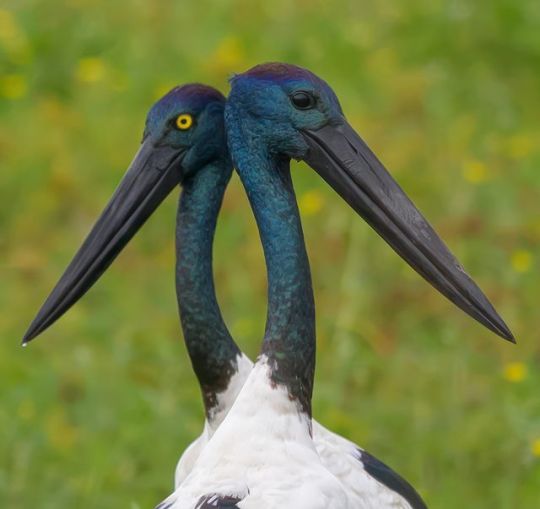
Black-necked Stork
#black necked stork#stork#Ephippiorhynchus asiaticus#Ciconiiformes#Ciconiidae#Ephippiorhynchus#bird#upl
166 notes
·
View notes
Text

Black-necked stork (Ephippiorhynchus asiaticus)
Photo by Fabrice Stoger
#black necked stork#ephippiorhynchus asiaticus#ephippiorhynchus#ciconiidae#ciconiiformes#pelecanimorphae#neognathae#aves#archosauria#reptilia#tetrapoda#vertebrata#chordata
30 notes
·
View notes
Text

The Australian Mycteria (Mycteria australis) | Joseph Wolf | Zoological sketches v.1 (1861) | Biodiversity Heritage Library | Flickr | Public domain
1 note
·
View note
Text
Black Necked Stork
Black Necked Stork is a tall bird. It is a water wading bird. It’s scientific name is Ephippiorhynchus asiaticus). It has a long neck.
The bird is found in wetland habitats near rice fields where it forages on many types of prey. The bird is a resident of Indian subcontinent and Southeast Asia.
Female : credit Ranjit Singh
The eyes of the female bird are golden whereas that of male are black.…
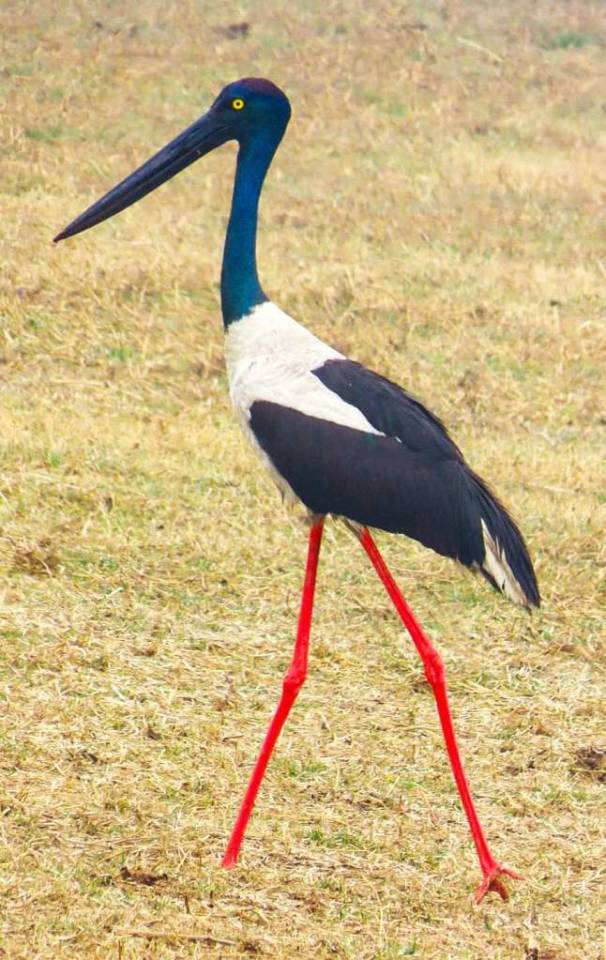
View On WordPress
0 notes
Photo

"The Eyes Have" It
Bird: Black-necked Stork, Howard Springs, NT
By Michelle Gardner
BirdLife Australia Photography Awards
#michelle gardner#photographer#birdlife australia photography awards#black-necked stork#stork#bird photography#bird portrait#nature#howard springs#northern territory#animal
251 notes
·
View notes
Text

[1242/10977] Black-necked Stork - Ephippiorhynchus asiaticus
Order: Ciconiiformes (storks)
Family: Ciconiidae
Photo credit: Ged Tranter via Macaulay Library
114 notes
·
View notes
Text

Black-necked Storks (Ephippiorhynchus asiaticus), L - female and R - male, family Ciconiidae, order Ciconiiformes, Jamnagar, India
photograph by Atish Chapadiya
1K notes
·
View notes
Text

Black-necked Stork (Ephippiorhynchus asiaticus) in India by Sumit Vyas.
183 notes
·
View notes
Text
A sequel to this drabble. Though I admit it was a little harder than the other.
While writing half of this I was thinking about that scene from the movie storks when they fight the penguins.
..................
He truly didn’t know what was worse, protecting his son from his past self or this.
His dear son, curled up in the throes of slumber against the chest of that loathsome heathen who so daringly has his arms wrapped loosely around his boy’s torso, leering down at Lilia from his chin’s perch on silver’s shoulder ‘what’s the matter old boy, that glare doesn’t suit a cute face like yours’ Lilia scowls at him and replies with an all too familiar gesture that would surely have Silver reprimanding him were he awake, alas twas not so instead his precious son was captured in such an image that Lilia would be cooing all over him, if it weren’t for this one abhorrent factor, who knowingly smirks back at Lilia with all the smugness more suited for a mischievous cat.
After the small incident where Lilia had beat the ever loving daylights out of his younger self, poor Silver had been wracked with miserable guilt despite his father’s protestations, claiming that he had been careless and had startled Vanrouge, thus to Lilia’s displeasure he wanted to make amends with the wild fae but ever since the incident Lilia had practically glued himself to Silver’s side whenever the general was in sight even going as far as to hissing at the fae whenever he thought he was too close to his son. As such Vanrouge kept a wide berth with his head down low and Lilia would have gladly left it at that but of course when it came to things like this Silver was rather persistent. For days Lilia watched scornfully as his dear boy ventured out to look for Vanrouge, sometimes he just couldn’t understand the extent of Silver’s kindness. Just mere days ago he had been attacked by the very fae he was searching very intently for and still Silver wishes to apologise to make amends no matter how many times Lilia tried to advise that it was near impossible to reason with a beast like him at that age, the bloodlust was too far ingrained and hadn’t time to rust away. But never did Silver give up and every time they found Vanrouge he would harshly refuse whatever Silver brought as a peace offering, personally Lilia was rather offended when the rats were rejected, it took him hours to catch all of them at Silver’s behest, but oh well more for Lilia. It had been this way for some time until suddenly one day Vanrouge was found begrudgingly eating risotto next to a triumphant Silver, really what was Lilia expecting, of course his son was capable of taming even the most rabid of beasts. But did it really have to be this beast? ‘Pray, do tell how this came to be? You’ve better not be holding him hostage, Vanrouge’ he growls hands on his hips and eye almost irritably twitching as his son shuffled in his sleep and almost buried his face in the general’s neck ‘why I’ve not the slightest clue myself, the poor thing just waltzed in here all dazed like and next thing you know he’s crawling up to me before dropping like so’ he smugly explains, nuzzling his cheek against silver locks. Oh you little…
The snide, conniving look he gives Lilia gives him the unshakable urge to bloody it black and blue again ‘why there was no hesitation whatsoever, he must have mistaken me as his father or something’
‘Of course he would, we have the same face!’ As much as he’d hate to admit, Silver’s recognition was never the best whenever a sleep spell hit him and Lilia did teach the boy to seek him out when he felt one coming. Oh well it can’t be helped he thinks reaching out to carry his boy off to the comforts of his bed only to gasp in indignation when sharp fangs clamp firmly into his hand. There’s a heavy pause as Lilia stares down at Vanrouge, who curls closer to his son, the promise of a slow, painful death blazing in his crimson eyes, yet the general was not intimidated in the slightest, of course not, what with the firm yet gentle way he manoeuvres Silver off him and down on the couch cushions, all without breaking eye contact or releasing his fang’s grip, so Lilia takes the ample opportunity to seize the ponytail he was so glad to shear off in his youth and send them both tumbling to the ground whose soft rug muffled the thud. In a silent brawl the two fae once again bite and kick at each other, daring the other to so much as make a sound and wake up the sleeping child above them, in a sense to Lilia it was a way to prove to himself that this younger version of him was just as he believed he was, a ruthless monster entirely incapable of caring for others, even if it was merely staying quiet just so his child could nap in peace. Yet as they scrapped Vanrouge refused to yield, showing off his familiar prowess by moving so that like Lilia, any blow thrown and received was muffled in some way. At one point they paused in fear when they heard a soft groan but Silver simply turned around and fell silent once more, suddenly Vanrouge whips out a fork of all things and drives it into Lilia’s arm. Lilia cried out in pain but toned it down to a quiet squeal, he rips out the fork and plunged it into the general’s shoulder who’s face blanked on impact and all of a sudden seized a spare cushion from the couch and screamed into it. Lilia would have found the whole thing hilarious had it been anyone else brawling like this.
In the background a certain Zigvolt raises an unimpressed eyebrow at the strange scene before him, honestly this would be a lot more impressive if the two fae weren’t trying to throttle the other in total silence. Wait, are they mouthing death threats to each other? Usually Sebek would never in his life dare to roll his eyes at Master Lilia but what was he to do? This was far too ridiculous, and Silver was bound to get a sore neck with the position he was in.
The two scrabbling generals didn’t even noticed Sebek walking around them towards Silver where he swung his fellow guard’s arm round his neck and hoisted him into his arms, may as well get him to bed, he thought as he carefully slipped out of the room, looking back to the still fighting Lilia’s, now I understand what Grandfather meant when he said that Master Lilia could be an idiot. Seven help him, these old fae were so oblivious.
79 notes
·
View notes
Text
Fossil Novembirb 15: Oasis in the Desert
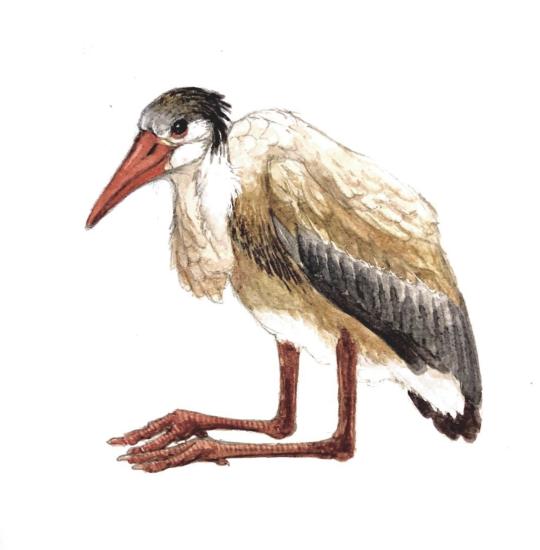
Xenerodiops by @iguanodont
We FINALLY get to an ecosystem that isn't in Europe, North America, Antarctica, or Oceania - it's Jebel Qatrani Time!
(If you are as appalled as I am at the low sampling rates of fossil localities in Asia, South America, and Africa, welcome to the club, and support paleontologists who are from and work in countries from those continents!!!)
The Jebel Qatrani Formation is an ecosystem from Egypt at the end of the Eocene through the early Oligocene. It showcases the tropical forests, swamps, and marshes that existed at this time, emptying into the Tethys Sea. A wet and humid environment, it would have been a weird mixed ecosystem, with both the old and the new coexisting on the riverbanks. And, like in the forests and plains of Oligocene Europe, we see many modern bird groups show up for the first time here - and also very similar to their living relatives! This is a departure from the mammals in the region, which were unique and weird for the time period (though early members of modern groups are found here, too).

Palaeoephippiorhynchus by Bubblesorg
Being a wetland and humid environment, the main feature of the avifauna here are aquatic birds - many of which have close relatives today. Palaeoephippiorhynchus is the oldest known fossil stork, and was remarkably similar to the living Saddle-Billed Stork - even having the same upcurved bill. While it's uncertain if they're close relatives or not, it is possible that living Saddle-Bills are similar to this ancient form. There was also a mid-sized heron, a bird extremely similar to living Black-Crowned Night Herons, and Xenerodiops - a heron with a pointed and strong bill, curved downward - good for grabbing onto prey. It was a very sturdy, robust bird - even for a heron.
In addition, there was Goliathia - the fossil Shoebill! This bird had legs much like the living shoebill, and was similar enough in the limbs that it might be in the same genus! It probably lived very similarly to living shoebills, feeding on fish in the wetlands around it. What its beak would have looked like is uncertain - the closest living relative to the Shoebill is the Hammerkop, which has a very different skull. What their ancestral skull was, or what Goliathia's was, remains a mystery.

Goliathia by Antonio Rares Mihaila
But if you think I'm done with the water birds, you're very wrong - this is just the beginning! There was also an indeterminant cormorant, which had a very hooked and tapered beak; birds similar to living crowned cranes and others like living flufftails; early jacanas like Janipes which was bigger than all living jacanas but still had the large feet for floating on vegetation, showcasing the vegetation in these wetlands was sturdy enough to hold it up; other early jacanas smaller in size as well like Nupharanassa; and of course -
The Flamingos! Well, yes and no. There was an indeterminate crown-flamingo (ie in the group that all living flamingos are in), a bit bigger than a living lesser flamingo. But there was also Palaelodus - one of the "Grebe-Flamingos" or "Swimming-Flamingos", a long-lasting group of birds that first appear in the early Oligocene and lasted until possibly the Pleistocene! They looked superficially similar to living flamingos and were more closely related to them than to grebes, but they did have some similar characteristics to grebes as well - specifically having less of a kink in the neck, shorter lower legs, and flatter limb bones like those in grebes. They also had webbed feet, which would have allowed for diving or swimming. It also had a straight, conical bill, very unlike the bill of living flamingos.
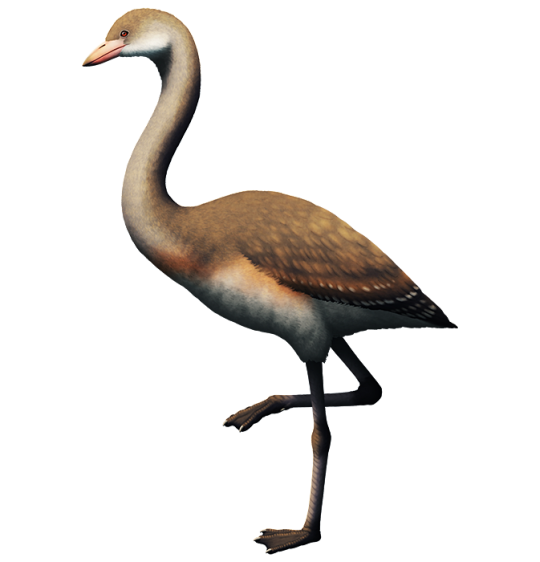
Palaelodus by @alphynix
There were also perching birds, such as an early turaco very similar to the living genus Crinifer; and early eagles, ospreys, and other birds of prey that haven't really been named - mainly because they are very similar to living species, but so distant in time it seems unlikely they'd be in the same genus still... right? One, very similar to the living sea eagle, was found near the shore - indicating a similar ecology to its living relative. Another was almost identical to the living osprey, just smaller in size. And another was similar in size to living ospreys, but more robust than them. This place was filled with raptors!
Of course, I can't ignore the metaphorical elephant in the room. One of the most mysterious birds of the Jebel Qatrani is Eremopezus, a bird that has similarities to so many different groups of birds that its exact position is still a mystery. At this time it is thought to be a Palaeognath, possibly closely related to ostriches or maybe elephant birds - as the volant Lithornithids start to disappear, ratite-like Palaeognaths become more and more common. It was flightless, and probably lived similarly to modern ostriches and other ratites - as a a large herbivore, probably taking advantage of the wetland landscape and the abundance of food.

Eremopezus by @thewoodparable
Jebel Qatrani is such an important formation because it sheds light on the evolution of even more bird groups than those we see in former Laurasia (North America + Eurasia). And it is possible that many lineages we still have in Africa today have been around for thirty million years - and may have been very similar in ecology and appearance during that whole time. Given living birds react to changing climates by shifting with the ecosystems, it's possible that these lines of birds similarly followed the migration of wetlands and other habitats during the climate change to come, persisting to this day across the continent.
Sources:
Kampouridis, P., J. Hartung, F. J. Augustin. 2023. The Eocene-Oligocene Vertebrate Assemblages of the Fayum Depression, Egypt. The Phanerozoic Geology and Natural Resources of Egypt. Advances in Science, Technology, & Innovation. 373-405.
Mayr, 2022. Paleogene Fossil Birds, 2nd Edition. Springer Cham.
Mayr, 2017. Avian Evolution: The Fossil Record of Birds and its Paleobiological Significance (TOPA Topics in Paleobiology). Wiley Blackwell.
Rasmussen, D. T., S. L. Olson, E. L. Simons. 1987. Fossil birds from the Oligocene Jebel Qatrani formation Fayum Province, Egypt. Smithsonian Contributions to Paleobiology 62(62): 1-20.
71 notes
·
View notes
Text
Fossil Novembirb: Day 15 - Oasis in the Desert

During the Late Eocene and Early Oligocene, the environment of Jebel Qatrani formation of Faiyum, Egypt was as lush as you could imagine, with tropical forests, and a vast system of wetlands, lakes and rivers connecting to the warm Tethys Sea. As you would expect, such a place was teeming with birds. The birds living here would have no idea that 30 million years later, the Sahara desert would bury all this greenery. But for now, it is an oasis where birds of a feather flock together.
Goliathia: One of the earliest known relatives of the shoebill, arguably one of the most awesome birds alive today.
Nycticorax: An early member of the modern night-heron genus. It is not named, but can be assigned to the genus thanks to the shape of its limb bones.
Xenerodiops: An early member of the stork family with a short, recurved beak. It probably fed like modern wood storks, probing the water with the beak open, snapping it shut on passing fish.
Nuphranassa: A member of the modern jacana group, but much larger than any living species at about the size of a chicken.
Janipes: Another large jacana. Not as large as Nuphranassa, but still larger than any modern jacana. One must wonder what these guys were walking on.
Palaeoephippiorhynchus: An early stork well known from this period. It closely resembles the saddle-billed and black-necked storks, but was markedly smaller in size.
Eremopezus: A very poorly know flightless palaeognath known from a few fragmentary limb bones. Probably related to modern ostriches.
#Fossil Novembirb#Novembirb#Dinovember#birblr#palaeoblr#Birds#Dinosaurs#Cenozoic Birds#Goliathia#Nycticorax#Xenerodiops#Nuphranassa#Janipes#Palaeoephippiorhynchus#Eremopezus
55 notes
·
View notes
Text
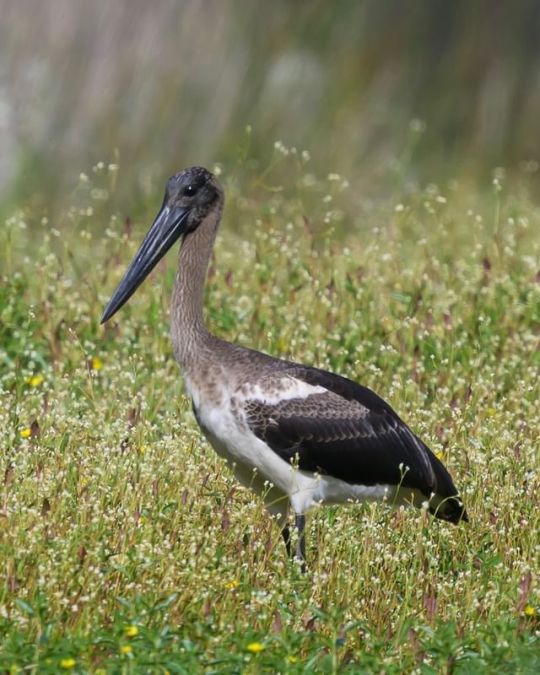
Black-necked Stork
#black necked stork#stork#Ephippiorhynchus asiaticus#Ciconiiformes#Ciconiidae#Ephippiorhynchus#upl#bird
47 notes
·
View notes
Text
General Vulture Fun Facts
Just to share some more love!
Vultures in general
Vultures are critically important to keeping an ecosystem healthy by cleaning up carcasses and preventing the spread of disease. They have incredibly acidic stomachs with a pH of about 1, causing them to be able to digest diseases including rabies and anthrax. Through eating carrion, they destroy harmful bacteria found in rotting meat.
Vultures are a major conservation concern. Of the 23 species of vultures, 9 are critically endangered, 2 are endangered, 2 are vulnerable, 3 are near threatened, and 7 are least concern.
Most vultures have featherless necks and heads. This is partially to help them stay clean when they feed by reaching their heads into carcasses; with bald heads, they can more efficiently clean their heads and the sun can bake off detritus more easily. This adaptation also helps them regulate their temperatures.
Old World and New World vultures are only superficially similar in filling similar ecological niches. I'll go into more depth below!
Old World Vultures
Old World vultures are members of the order Accipitiformes and family Accipitridae, which includes hawks and eagles. Many of these vultures are no more closely related to one another than they are to other members of Accipitridae.
They can be generally divided into two major clades, Aegypiinae (cinereous, red-headed, lappet-faced, white-headed, hooded, and all Gyps vultures) and Gypaetinae (bearded, palm-nut, and Egyptian vultures).
While some New World vulture species forage using their sense of smell, Old World vultures have poor senses of smell and find food exclusively via sight.
Many Gyps vultures are known as griffon vultures in at least one of their common names (G. fulvus, Eurasian griffon vulture; G. coprotheres, cape griffon; G. rueppelli, Rüppell's griffon vulture; G. himalayensis, Himalayan griffon vulture).
Most Old World vulture species are of conservation concern. The most dramatic declines are in Asia due to accidental poisoning by diclofenac, a problem known as the Indian Vulture Crisis. It is caused by cattle being treated with the drug diclofenac; when these cattle die they are consumed by vultures, but diclofenac causes fatal kidney failure in vultures. This crisis largely affects Gyps and red-headed vultures and has caused a 99% decrease in Indian vulture populations since about 1990. Major declines in Africa are caused by poaching and intentional poisoning.
In ancient Egypt, vultures were associated with purity and motherhood as well as the cycle of death and rebirth.
New World Vultures
New World vultures are placed in the family Cathartidae, but nobody can agree where to put Cathartidae. It was originally in the order Falconiformes. It was then moved to the order Ciconiiformes (storks and herons) due to erroneous studies but later removed. New World vultures are now considered to be most closely related to Accipitriformes raptors, and Cathartidae may now be placed in Accipitriformes with the Old World vultures, or in its own closely-related order Cathartiformes.
These vultures can be generally grouped into two clades, one consisting of the black vulture and the Cathartes vultures, and the other including the king vulture and both species of condor.
New World vultures do not posses a syrinx (bird voice box), and so can only hiss and grunt as vocalizations.
Cathartes vultures, meaning the turkey vulture and both yellow-headed vultures, are some of the few birds to have a good sense of smell. This sense makes them the most efficient birds at finding carrion.
Black and king vultures as well as condors will follow Cathartes vultures to carcasses, where they generally tend to dominate. Condors and king vultures are larger than Cathartes vultures, while black vultures are more aggressive. However, these larger vultures are needed to tear open tough carcasses. Therefore, large vultures and Cathartes vultures rely on one another to effectively access food.
New World vultures do not build nests but rather lay their eggs directly on bare surfaces such as cliff ledges.
They cool off via urohidrosis, or urinating on their legs. They cool off as the waste evaporates, similar to how humans cool off as sweat evaporates. This process also kills bacteria accumulated on the legs at carcasses.
King and black vultures are often found depicted in Mayan codices. The king vulture is considered a divine messenger and used to depict the thirteenth day of the month, while the black vulture is associated with death and aggression.
New World vultures may vomit when threatened in order to distract the threat and to lighten themselves enough to take off quickly.
167 notes
·
View notes
Text

Didn't put too much thought into this week's Bestiary Posting, the Blisheag, but I still like what I came up with.
The reference to a 'bill' made me think of a duck initially so that's what I leaned into. (It is kind of weird how some birds definitely have 'beaks' and others definitely have 'bills' and I know which one's have which, even though 'beak' and 'bill' are apparently synonyms. English is so weird.)
The reference to being an 'enemy to snakes' made me think of the secretary bird, so I gave it relatively long legs and claws to deal with those slithering serpents. Lastly, I know storks clack their bills, and decided that this bird needed a long bill and neck like a stork. I also tried to slim down and make the body a bit more 'stork like' as with it's long legs, claws and beak it really feels like more of a wading bird then a dabbling duck.
For coloration I referenced the American Black duck, just because I think they're quite a handsome duck.
17 notes
·
View notes
Text
My birding week vacation is over, so here are all the bird species I saw:
1. Little blue heron
2. Sharp-shinned hawk
3. Black vulture
4. Great egret
5. Sandhill crane
6. Mourning dove
7. Common loon (there were two of them just hanging out at a lake. We couldn't believe it but they were unmistakable)
8. Cattle egret
9. Great blue heron
10. Anhinga
11. Double-crested cormorant
12. Red-winged Blackbird
13. Limpkin
14. Wood stork
15. White ibis
16. Muskovy duck
17. Boat-tailed grackle
18. American crow
19. American coot
20. Common gallinule
21. Common grackle
22. Glossy ibis
23. Palm warbler
24. Osprey
25. American purple gallinule
26. Wood duck
27. Red-shouldered hawk
28. Pied-billed grebe
29. Royal tern
30. Eastern Phoebe
31. Roseate spoonbill (last year it eluded me, but this year I saw two at two separate locations!)
31. Black-bellied whistling duck
32. Tricolor heron
33. Northern harrier
34. Yellow-rumped warbler
35. Tree swallow
36. Swallow-tailed kite
37. Ring-billed gull
38. Turkey vulture
39. Mallard
40. White pelican (there were two just hanging out at an artificial lake in the middle of a residential area)
41. Red eyed vireo
42. Mulard
43. American pekin
44. Mallard/Pekin hybrid
45. Downy woodpecker
46. Grey catbird
47. Blue-grey gnatcatcher
48. Fish crow
49. Northern parula
50. Snowy egret
51. Chimney swift
52. Common yellowthroat
53. Bald eagle
54. Red-bellied woodpecker
55. Blue winged teal (we only saw these guys because we had to walk an extra 1.5 miles to take the long way back to the car because an alligator decided to block our short way back)
56. Great-crested flycatcher
57. Louisiana waterthrush
58. Laughing gull
59. Northern mockingbird
60. Mottled duck
61. Loggerhead shrike
62. White eyed vireo
63. Tufted titmouse
64. Northern cardinal
65. Black and white warbler
66. Ring-necked duck (I saw this lone duck from the car as we were driving past an artificial lake. From it's silhouette I could see it looked different from the other ducks common in the area, so we stopped the car literally on the side of the road so I could run out with my binoculars, and sure enough it was a new species to add to the list. And then when we came back a few days later, it was still there swimming around and diving, so I guess it lived around there.)
67. Carolina chickadee
68. Swamp sparrow
69. Ruby-crowned kinglet
70. Pileated woodpecker
71. Belted kingfisher (we visited the same place three times because my Grandpa saw kingfishers there a few times. It wasn't until the third and final time, while we were ready to give up and leave, that we saw it, perched on a sign post over the water)
72. House sparrow
73. Cooper's hawk
74. Carolina wren
75. White-throated sparrow
13 notes
·
View notes
Text
Birds of Dorthonion
Flora, fauna, geography and environment of Arda Masterlist
Dorthonion was a region north of greater Beleriand. It was a cool region covered in steep slopes, conifer forests and Heath covered highlands. The mountain range Ered Gorgoroth bordered it on the south and above it was the fields of Ard Galen. It was inhabited by the Arafinwëan host following Aegnor and Angrod and later, the human host following Bëor. Nomadic and semi nomadic groups of the northern Sindar and Avari also possibly lived there
As always I included world building notes at the end so it’s not just a list of species
In the conifer forests: black grouse, willow tit, goldcrest, mistle thrush, pine grossbeak, common tree creeper, common redstart, black woodpecker, chiffchaff, coal tit, common raven, crested tit, wood grouse, goshawk, spruce grouse, black throated thrush, pine bunting, boreal owl
The highlands and around Tarn Aeulin: graylag goose, common nightjar, common kestrel, snow crane, hen harrier, tundra swan, horned grebe, common crane, blue duck, water rail, black francolin, northern pintail, velvet scooter, great bittern, pallid harrier, rough legged hawk, little egret, wood lark, corn crane, black necked grebe (migratory), garganey, Merlin
The cliffs and slopes: see see partridge, rock dove, great bustard, long legged buzzard, common quail, black headed bunting, booted eagle, chukard, barred warbler, northern wren, little owl, white throated dipper (near Rivil’s well), black winged kite, steppe eagle, roller
The mountain border: bearded vulture, red fronted serin, black stork, snowcock, horned lark, rock bunting, wallcreeper, blue rock thrush, red kite, peregrine falcon, golden eagle (rare), white wagtail
World building notes:
-The vague images of pine grossbeaks were embroidered on the blankets of Bëorian children using a diluted version of the dyes created from blood madder and coal. The name in Bëorian Taliska translates to pine song bird.
-The Arafinwëan host of Dorthonion as well as some of the Avarin groups hunt with birds of prey which are also used by some of the scouts. Kestrels and Harriers are the most commonly used species. The practice is less common than among the Noldor of Eastern Beleriand however.
-Feathers (usually of peregrine falcons or common kestrels) were also used as a method of communication among Arafinwëan scouts during the times of year where weather would allow for this, left in strategic locations, lodged into the earth or tucked into trees to indicate presence or dangers.
-Eggs of various ground species were eaten by the Bëorian population and there was a practice of burying the eggshells. This was learned from the elves of Ossiriand prior to their settling in Dorthonion.
-Birds eggs appear in Northern Sindar art, in or separate from nests. Though the eggs of certain species have different meanings, they are commonly associated more generally with fragility and defense. Their images may be created through pigments made from certain actual eggshells as well as minerals and plant based dyes. One common motif involves a nest of eggs upon a steep slope or cliff.
-Birds appear throughout Bëorian songs and poems. Most commonly mentioned are the general name for the “fisher birds” (wading and diving birds) seen on and around Tarn Aeulin, as well as several of the smaller songbirds found in the pine forests such as pine grosbeak, tree creepers, and thrushes. After the Bragollach the names for some species became lost or translated differently.
-Also it’s been a headcanon of mine for awhile that Baragund would take Morwen when she was a young child out to the cliffs to watch the birds. He would teach her to identify them by their call. She remembers a lot of them, even as an adult though they are called different names and their habits are often unfamiliar.
#the silmarillion#the children of húrin#Dorthonion#beleriand#musing and meta#Morwen#baragund#houseless for exiles#northern Sindar
23 notes
·
View notes